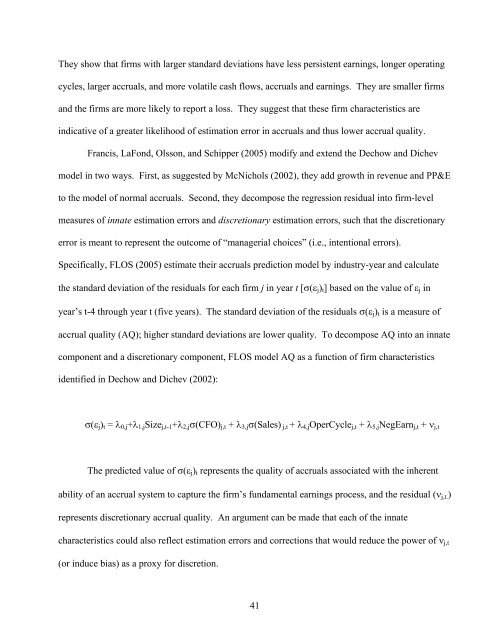Understanding earnings quality - MIT Sloan School of Management
Understanding earnings quality - MIT Sloan School of Management
Understanding earnings quality - MIT Sloan School of Management
Create successful ePaper yourself
Turn your PDF publications into a flip-book with our unique Google optimized e-Paper software.
They show that firms with larger standard deviations have less persistent <strong>earnings</strong>, longer operating<br />
cycles, larger accruals, and more volatile cash flows, accruals and <strong>earnings</strong>. They are smaller firms<br />
and the firms are more likely to report a loss. They suggest that these firm characteristics are<br />
indicative <strong>of</strong> a greater likelihood <strong>of</strong> estimation error in accruals and thus lower accrual <strong>quality</strong>.<br />
Francis, LaFond, Olsson, and Schipper (2005) modify and extend the Dechow and Dichev<br />
model in two ways. First, as suggested by McNichols (2002), they add growth in revenue and PP&E<br />
to the model <strong>of</strong> normal accruals. Second, they decompose the regression residual into firm-level<br />
measures <strong>of</strong> innate estimation errors and discretionary estimation errors, such that the discretionary<br />
error is meant to represent the outcome <strong>of</strong> “managerial choices” (i.e., intentional errors).<br />
Specifically, FLOS (2005) estimate their accruals prediction model by industry-year and calculate<br />
the standard deviation <strong>of</strong> the residuals for each firm j in year t [σ(εj)t] based on the value <strong>of</strong> εj in<br />
year’s t-4 through year t (five years). The standard deviation <strong>of</strong> the residuals σ(εj)t is a measure <strong>of</strong><br />
accrual <strong>quality</strong> (AQ); higher standard deviations are lower <strong>quality</strong>. To decompose AQ into an innate<br />
component and a discretionary component, FLOS model AQ as a function <strong>of</strong> firm characteristics<br />
identified in Dechow and Dichev (2002):<br />
σ(εj)t = λ0,j+λ1,jSizej,t-1+λ2,jσ(CFO)j,t + λ3,jσ(Sales) j,t + λ4,jOperCyclej,t + λ5,jNegEarnj,t + νj,t<br />
The predicted value <strong>of</strong> σ(εj)t represents the <strong>quality</strong> <strong>of</strong> accruals associated with the inherent<br />
ability <strong>of</strong> an accrual system to capture the firm’s fundamental <strong>earnings</strong> process, and the residual (νj,t.)<br />
represents discretionary accrual <strong>quality</strong>. An argument can be made that each <strong>of</strong> the innate<br />
characteristics could also reflect estimation errors and corrections that would reduce the power <strong>of</strong> νj,t<br />
(or induce bias) as a proxy for discretion.<br />
41
















